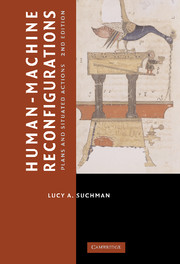Book contents
- Frontmatter
- Contents
- Acknowledgments
- Preface to the 2nd Edition
- Introduction
- 1 Readings and Responses
- 2 Preface to the 1st Edition
- 3 Introduction to the 1st Edition
- 4 Interactive Artifacts
- 5 Plans
- 6 Situated Actions
- 7 Communicative Resources
- 8 Case and Methods
- 9 Human–Machine Communication
- 10 Conclusion to the 1st Edition
- 11 Plans, Scripts, and Other Ordering Devices
- 12 Agencies at the Interface
- 13 Figuring the Human in AI and Robotics
- 14 Demystifications and Reenchantments of the Humanlike Machine
- 15 Reconfigurations
- References
- Index
2 - Preface to the 1st Edition
Published online by Cambridge University Press: 05 June 2012
- Frontmatter
- Contents
- Acknowledgments
- Preface to the 2nd Edition
- Introduction
- 1 Readings and Responses
- 2 Preface to the 1st Edition
- 3 Introduction to the 1st Edition
- 4 Interactive Artifacts
- 5 Plans
- 6 Situated Actions
- 7 Communicative Resources
- 8 Case and Methods
- 9 Human–Machine Communication
- 10 Conclusion to the 1st Edition
- 11 Plans, Scripts, and Other Ordering Devices
- 12 Agencies at the Interface
- 13 Figuring the Human in AI and Robotics
- 14 Demystifications and Reenchantments of the Humanlike Machine
- 15 Reconfigurations
- References
- Index
Summary
Thomas Gladwin (1964) has written a brilliant article contrasting the method by which the Trukese navigate the open sea, with that by which Europeans navigate. He points out that the European navigator begins with a plan – a course – which he has charted according to certain universal principles, and he carries out his voyage by relating his every move to that plan. His effort throughout his voyage is directed to remaining “on course.” If unexpected events occur he must first alter the plan, then respond accordingly. The Trukese navigator begins with an objective rather than a plan. He sets off toward the objective and responds to conditions as they arise in an ad hoc fashion. He utilizes information provided by the wind, the waves, the tide and current, the fauna, the stars, the clouds, the sound of the water on the side of the boat, and he steers accordingly. His effort is directed to doing whatever is necessary to reach the objective. If asked, he can point to his objective at any moment, but he cannot describe his course.
(Berreman 1966: 347)The subject of this book is the two alternative views of human intelligence and directed action represented here by the Trukese and the European navigator. The European navigator exemplifies the prevailing cognitive science model of purposeful action, for reasons that are implicit in the final sentence of the quote above.
- Type
- Chapter
- Information
- Human-Machine ReconfigurationsPlans and Situated Actions, pp. 24 - 28Publisher: Cambridge University PressPrint publication year: 2006

